Religion and Spirituality in the Philippines: An Intertwined Fabric
In the Philippines, religion and spirituality are deeply intertwined, shaped by the country's complex history. This blend is evident in the coexistence of indigenous beliefs, Catholic customs, and emerging Protestant sects.
Catholicism Remains Prevalent
The Catholic faith remains the dominant religion, influencing social identity and mental health support. For instance, many Filipinos attend Catholic masses and participate in religious processions, such as the Sinulog Festival in Cebu, which honors the Santo Niño (Child Jesus).
Spiritual Practices and Syncretic Traditions
Many Filipinos practice spiritual activities alongside their religious observances, creating syncretic traditions. Examples include the fusion of Catholic and indigenous beliefs in community festivals, such as the Pintados Festival in Tacloban, which honors the Santo Niño and features tattooed dancers.
Grassroots Movements Emphasize Personal Spirituality
In recent years, grassroots movements have emerged, focusing on personal spirituality. This shift reflects contemporary cultural changes, as Filipinos seek more individualized and meaningful spiritual experiences.
Dynamics in Philippine Society
As you explore the relationship between religion and spirituality in the Philippines, you'll uncover the complex interactions between these dynamics amid challenges and transformations in Philippine society today.
Historical Overview of Religion
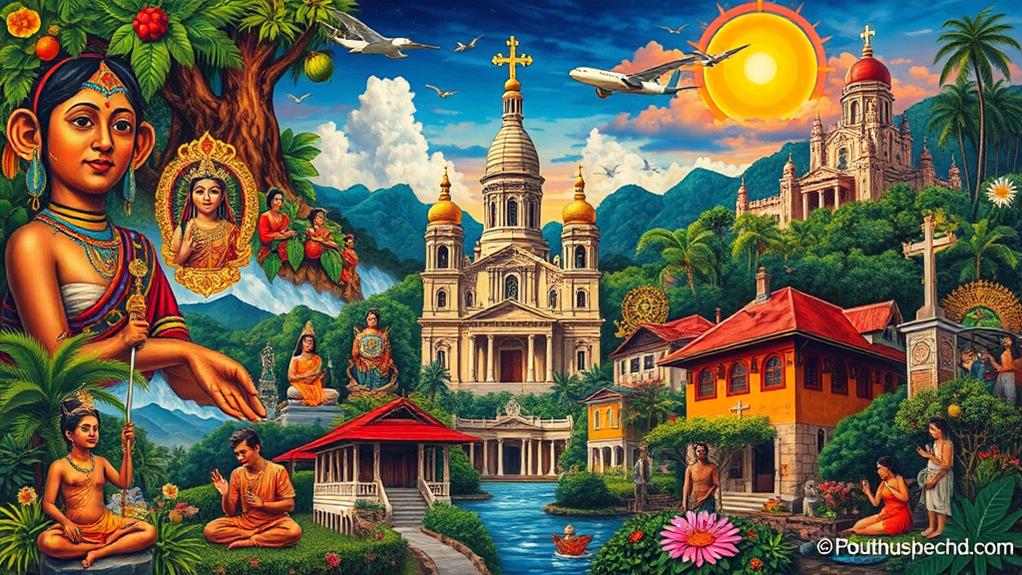
Religion in the Philippines has been shaped by a rich tapestry of historical influences.
Before the arrival of foreign influences, pre-Hispanic Filipinos engaged in indigenous religious practices, worshipping a pantheon of gods and spirits, with Bathala recognized as the supreme deity. Shamans and priests led rituals, fostering a deep connection to spirituality that shaped their daily lives.
The arrival of Islam in 1350 introduced a new religious influence, primarily in Mindanao and Sulu, which established political structures that intertwined with existing beliefs.
However, Spanish colonization in 1565 brought Catholicism to the forefront, promoting it as the dominant religion while blending with the existing animistic practices among rural populations.
The American colonial period saw the emergence of Protestantism, and nationalized churches like the Aglipayans gained traction.
Despite this, the Catholic Church remained the primary religious institution, reflecting the complexity of Filipino spirituality.
Today, the Philippines features a dynamic religious landscape, with small sects and fundamentalist groups challenging the Catholic Church's supremacy.
This ongoing evolution of beliefs and practices highlights the country's rich cultural context.
Indigenous Spiritual Practices
Indigenous spiritual practices in the Philippines are deeply connected to the environment. This connection is characterized by a rich tapestry of beliefs that predate colonization. In these beliefs, animism reigns, with a pantheon of gods and spirits guiding daily life. For example, Bathala, the supreme deity, represents the universe's creator. Rituals often involve sacrifices and prayers to appease both benevolent and malevolent spirits.
Shamans or priests possess supernatural powers to navigate these spiritual realms. They're seen as intermediaries between the spiritual and physical worlds.
Ancestor worship plays a significant role in these beliefs, as ancestral spirits are honored through wooden and metal images. This reverence showcases deep respect for lineage and heritage, highlighting how indigenous practices intertwine with Filipino identity.
Syncretism emerges when indigenous spiritual beliefs blend with later introduced religions like Catholicism. In many rural communities, a unique fusion exists where traditional practices coexist with Catholic rituals.
This dynamic reflects a cultural richness that continues to thrive, demonstrating how rooted these practices are within the Filipino experience, even amidst colonization and modernization.
Christianity's Influence
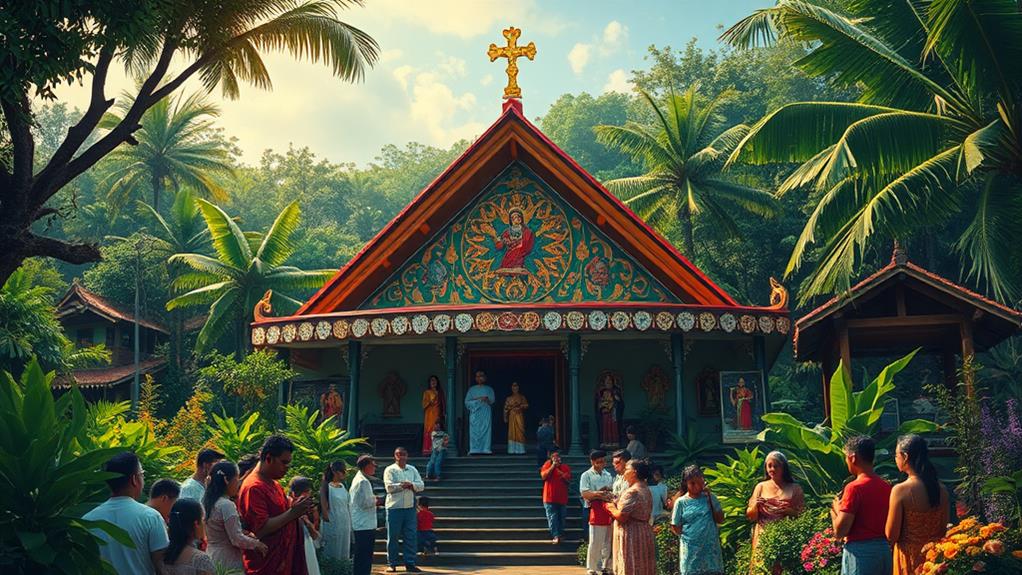
The Philippines' cultural landscape is shaped by the interplay between indigenous spirituality and Christianity, with 85% of Filipinos practicing Christianity, predominantly Catholicism. This faith significantly influences daily life and community structures, particularly in rural areas.
In many communities, Catholicism is a cornerstone of social identity, with parish priests playing a crucial role in spiritual guidance, local governance, and community events.
For instance, festivals and rituals combine Catholic traditions with indigenous customs, showcasing this integration. The town of Lucban in Quezon Province celebrates the Pahiyas Festival, where residents decorate their homes with vibrant rice paper decorations and hold processions in honor of San Isidro Labrador.
The Catholic Church's influence also extends to health practices, where faith healing is often merged with conventional medical care. Many Filipinos use spiritual resources to address physical ailments, such as seeking the intercession of saints or reciting prayers alongside medical treatment.
For example, the Our Lady of Lourdes Grotto in San Jose City, Nueva Ecija, is a popular pilgrimage site for those seeking healing.
While Catholicism remains dominant, the rise of diverse Protestant sects and fundamentalist groups highlights an evolving religious landscape. This shift demonstrates how Filipino religious practices continue to adapt to changing cultural contexts.
The growth of Evangelical Christianity, for instance, has led to an increase in Protestant churches and missionary work across the country.
Contemporary Religious Landscape
The Philippines' religious landscape is shifting beyond traditional Catholicism.
While approximately 85% of the population still identifies as Roman Catholic, the country is experiencing a growing diversity in religiosity and spirituality.
The Catholic Church faces challenges from emerging sects and fundamentalist groups seeking to redefine spiritual engagement.
Grassroots movements and nationalized churches, such as the Aglipayans, are gaining popularity. This trend reflects a desire for a more localized, culturally resonant faith experience, which often contrasts with the institutional rigidity of the Catholic Church.
For instance, the Aglipayan Church, established in 1902, has been a prominent example of a nationalized church that has been attracting followers.
The low priest-to-people ratio affects community engagement. With too few priests to serve the large Catholic population, the Church struggles to respond effectively to these emerging religious movements.
Tensions between religious groups and government authorities also exist. The complicated interplay of religion and politics is evident in conflicts and collaborations between diverse beliefs seeking common ground.
Cultural Syncretism in Beliefs
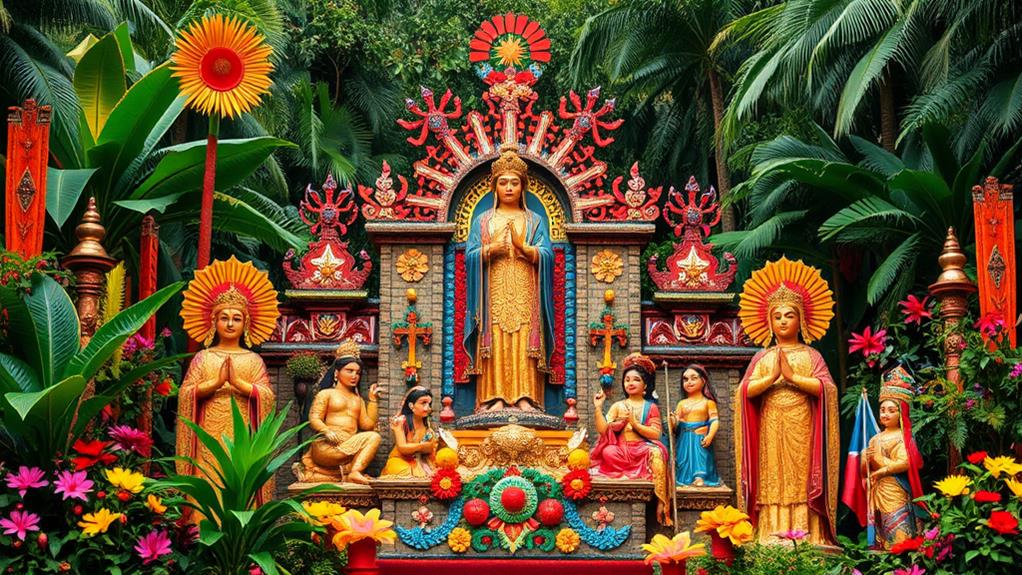
Cultural Syncretism in the Philippines
Cultural syncretism in the Philippines is a unique blend of beliefs that reflects the deep intertwining of spiritual practices in daily life. This fusion is prominently seen in the coexistence of indigenous beliefs with Catholicism, where traditional rituals rooted in reverence for ancestral spirits are seamlessly integrated into Christian celebrations.
Festivals celebrating patron saints showcase this syncretism, as they incorporate elements of indigenous animism, such as processions and rituals honoring both Christian and pre-colonial beliefs. For example, in the Fiesta de San Juan, a celebration honoring Saint John the Baptist, Filipinos engage in prayers to the saint while making offerings to local deities, demonstrating their duality in religious identity.
Grassroots religious movements also illustrate the ongoing evolution of spirituality in the Philippine context. These movements combine Christian teachings with local customs, further blurring the boundaries between established religion and indigenous practices.
One such movement is the Iglesia ni Cristo**, which incorporates elements of Filipino culture and folk practices into its Christian teachings.
Cultural syncretism in the Philippines isn't just a historical phenomenon; it's a dynamic interplay of spiritual practices that continues to shape the identities and experiences of Filipinos today.
Socio-Political Context of Religion
Religion plays a significant role in shaping the socio-political dynamics in the Philippines. The country's predominantly Catholic population, with around 85% adhering to Roman Catholicism, has led to the Catholic Church's influence in governance and community relations.
The Church's influence is evident in local festivals and community engagements, where church activities often dictate the events. This historical context, rooted in Spanish colonization, has fostered a strong Catholic identity, particularly in rural areas.
The Philippines isn't a homogeneous society in terms of religion. Muslim communities in Mindanao and Sulu have resisted Christian imposition, leading to ongoing tensions and separatist movements.
These movements highlight the nation's religious diversity. The rise of Protestant sects during the American colonial period has further fragmented the religious landscape, challenging the Catholic Church's supremacy and reshaping political affiliations.
The Catholic Church often finds itself at odds with government authorities. Contemporary issues, such as human rights and social justice advocacy, see the Church pushing for reforms and voicing the marginalized's struggles.
Spirituality intersects with activism in these instances. This complex interplay between religion and socio-political dynamics reveals how deeply intertwined cultural beliefs are with the quest for justice and equity in the Philippines.
Mental Health and Spirituality
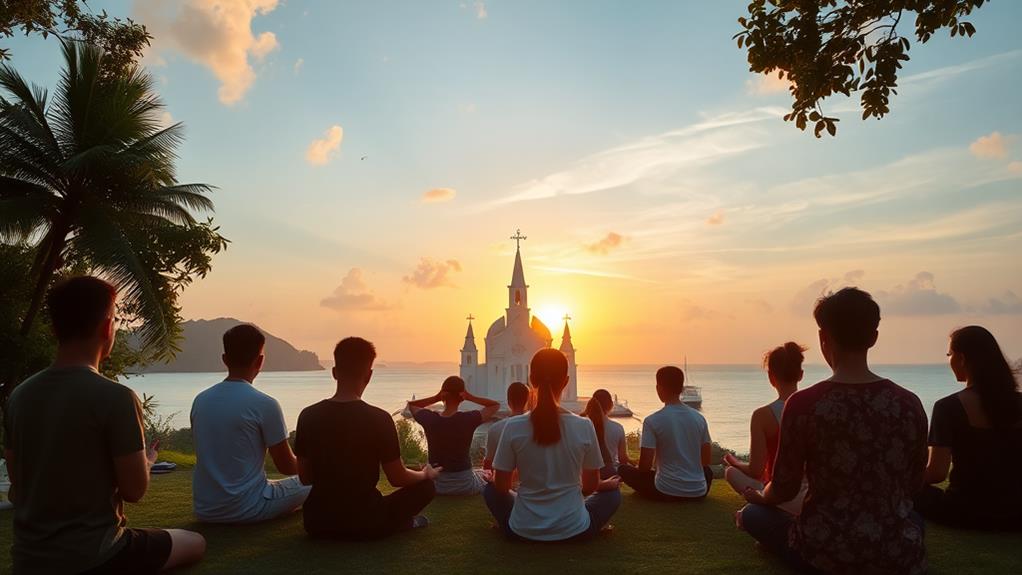
Mental Health and Spirituality in the Philippines
The Connection Between Mental Health and Spirituality
Many Filipinos find comfort in spirituality when dealing with mental health issues.
The Philippine Mental Health Law of 2018 recognizes the interconnectedness of physical, mental, and spiritual well-being. This understanding is rooted in the country's strong spiritual beliefs, which play a significant role in shaping mental health outcomes.
Spirituality as a Coping Mechanism
Spiritual practices, such as prayer, serve as essential coping mechanisms for Filipinos during difficult times.
These practices provide both emotional and spiritual support, enhancing therapeutic outcomes and fostering emotional resilience. In the Filipino context, integrating spirituality into mental health care creates a stronger bond between therapists and clients, promoting a holistic approach to treatment.
The Influence of Catholicism
The prevalence of Catholicism, practiced by approximately 85% of the population, strengthens community ties and support networks.
These networks are crucial in shaping perceptions of mental health and adherence to treatment. Consequently, spirituality and religiosity aren't only personal beliefs but also vital components of coping strategies that impact mental health in the Philippines.
How Does Filipino Spirituality Influence Religious Practices in the Philippines?
Filipino spirituality and nature connection deeply influence religious practices in the Philippines. Many Filipino religious traditions incorporate aspects of indigenous spirituality, such as honoring nature spirits and deities. This interconnectedness with the natural world shapes the beliefs and practices of the Filipino people, creating a unique religious experience.
Education and Community Engagement
Education and Spirituality in the Philippines
Education plays a vital role in connecting Filipino communities to their rich spiritual heritage and diverse religious practices. For instance, the Asia Society Museum's exhibition *Comparative Hell* showcases the significance of understanding Filipino religious practices alongside broader Asian cultures.
Community programs focused on cultural education help families and youth develop a deeper awareness of the complex religious landscape that shapes their identities.
Integrating Spirituality and Mental Health
Educational initiatives that intertwine spirituality and mental health are becoming increasingly important in community frameworks. This integration addresses the psychosocial needs of Filipinos influenced by their religious beliefs, enhancing resilience and support systems.
Faith-based organizations collaborate with mental health providers to deliver culturally relevant resources that resonate with the community's values. For example, the Catholic Educational Association emphasizes the importance of spirituality in education, with 97.40% of Filipino youth acknowledging religion's significance in their lives.
Fostering Community Engagement
By intertwining education and spirituality, Filipinos can cultivate a more cohesive and supportive community.
Active participation in school-based religious activities enriches community engagement and honors heritage. This approach ensures that the essence of Filipino identity thrives.
Future Trends in Spirituality
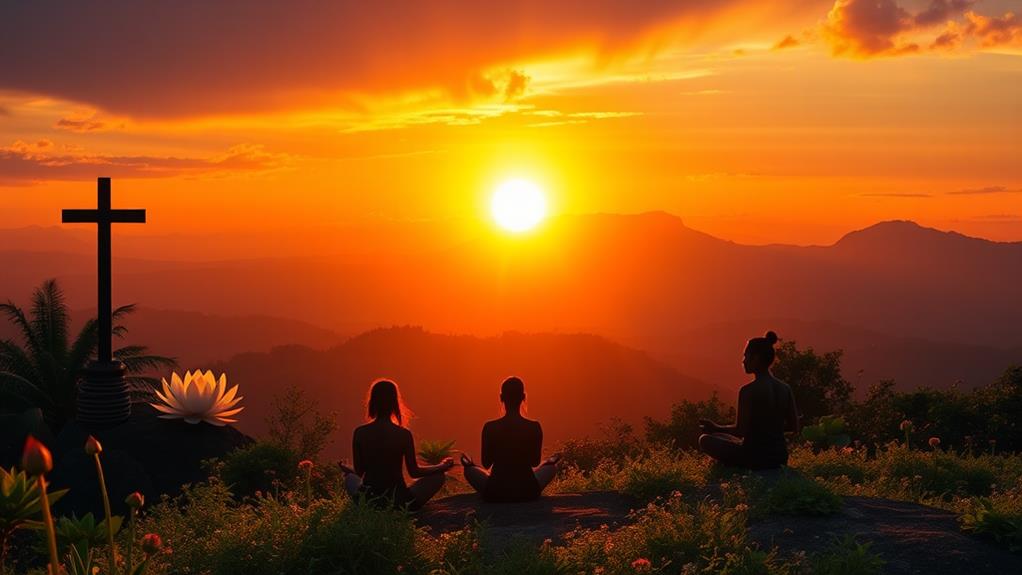
Spirituality in Filipino Communities is Evolving
As Filipino communities change, spiritual practices are shifting to reflect the broader cultural landscape. A rise in grassroots movements is challenging traditional religious structures, particularly as the Catholic Church faces a low priest-to-people ratio. These movements prioritize individual spirituality, focusing on holistic approaches that align with the Philippine Mental Health Law of 2018, which incorporates spiritual well-being into public health frameworks.
Individualized Spirituality is on the Rise
This trend highlights a growing interest in personal practices like prayer and community rituals, allowing individuals to explore their beliefs outside of organized religion.
Social media and technology play crucial roles in this evolution, creating virtual communities that foster spiritual support and connection among like-minded individuals.
Cultural Diversity is Enriching the Spiritual Landscape
As cultural diversity flourishes, the interplay between indigenous spirituality and established religious traditions is likely to result in new forms of syncretism.
This enrichment of the spiritual landscape reflects the unique identity of Filipino communities, inviting individuals to engage with a more dynamic and inclusive understanding of spirituality that honors both their heritage and personal journey.
Questions and Answers
What Are the Religious and Spiritual Practices in Philippines?
Religious and Spiritual Practices in the Philippines
Blend of Faith Traditions and Cultural Beliefs
In the Philippines, religious and spiritual practices are deeply rooted in the country's cultural heritage.
Filipino rituals often combine Catholicism, Islam, and indigenous beliefs, resulting in a unique blend of faith traditions.
Community Gatherings and Celebrations
Community gatherings play a vital role in fostering social connections, often centered around religious festivals and celebrations such as the Sinulog Festival in Cebu and the Feast of the Black Nazarene in Manila.
These events bring people together, reinforcing communal ties and showcasing the country's rich spiritual tapestry.
Personal Devotion and Inner Peace
Filipinos also engage in various spiritual practices to cultivate inner peace and personal devotion.
Meditation and prayer are common practices, helping individuals find solace in their daily lives.
These spiritual expressions not only reflect personal faith but also contribute to the country's vibrant cultural landscape.
What Is the Connection Between Religion and Spirituality?
Religion and spirituality are interconnected yet distinct concepts.
Religion provides a structured belief system that shapes cultural identity and offers a framework for understanding the world. For example, Christianity, Islam, and Buddhism are all religions that provide guidelines for their followers. These belief systems often influence daily life, traditions, and values.
Spirituality, on the other hand, is a more personal and individual experience that transcends religious structures. It involves a deep connection with oneself, others, and the universe, leading to personal growth and self-awareness. Spirituality can be practiced within or outside of religious contexts.
In diverse religious landscapes, people often intertwine their spiritual journeys with organized practices, fostering a sense of belonging.
For instance, a Christian might practice meditation to deepen their spiritual connection with God, while a Buddhist might participate in group chanting to cultivate inner peace. This blending of spirituality and religion encourages individuals to reflect on the essence of existence and their place within a broader community.
Why Is Religion Important to the Philippines?
Religion plays a vital role in shaping the cultural identity of the Philippines. This is evident in the way it influences daily life, instilling moral values and guiding people's behavior.
For instance, the Catholic Church's emphasis on family and respect for authority is reflected in Filipino customs and traditions.
Religion also fosters community bonding, uniting people during festivals and rituals.
The Philippines' vibrant fiestas, such as the Sinulog Festival in Cebu, showcase the country's rich cultural heritage and strong religious roots. This blend of colonial legacies and local traditions promotes social stability, providing a framework for cooperation and support in times of crisis.
In essence, religion isn't just a belief system in the Philippines; it's an integral part of the country's social fabric. It provides a sense of belonging, comfort, and guidance, which is essential for building strong communities and a stable society.
What Is Spirituality in Filipino?
Spirituality in Filipino culture is deeply rooted in personal identity and collective heritage. It's shaped by a blend of ancestral wisdom and cultural traditions, which influence an individual's worldview.
Filipino spirituality is characterized by a strong connection to family and ancestors, often expressed through rituals, community gatherings, and prayers.
These practices serve a dual purpose: they provide personal fulfillment and strengthen bonds within the community.
For Filipinos, spirituality isn't just a personal journey but an integral part of their collective identity. It is a way to honor ancestors and connect with their cultural heritage.